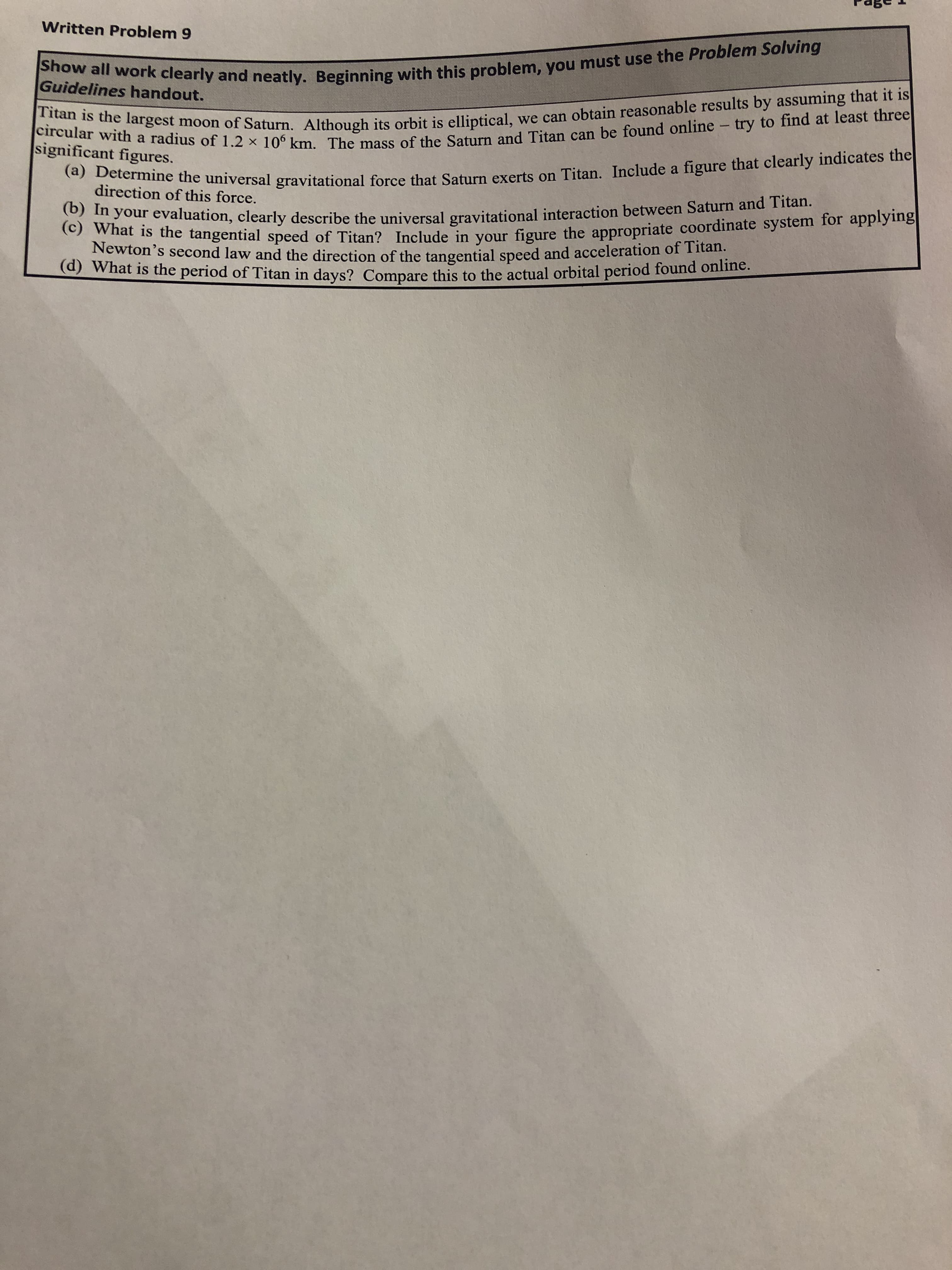Written Problem 9 Show all work clearly and neatly. Beginning with this problem, you must use the Problem Solving Guidelines handout. Titan is the largest moon of Saturn. Although its orbit is elliptical, we can obtain reasonable results by assuming that it is circular with a radius of 1.2 x 10° km. The mass of the Saturn and Titan can be found online - try to find at least three significant figures. (a) Determine the universal gravitational force that Saturn exerts on Titan. Include a figure that clearly indicates the direction of this force. (b) In your evaluation, clearly describe the universal gravitational interaction between Saturn and Titan. (c) What is the tangential speed of Titan? Include in your figure the appropriate coordinate system for applying Newton's second law and the direction of the tangential speed and acceleration of Titan. (d) What is the period of Titan in days? Compare this to the actual orbital period found online.
Written Problem 9 Show all work clearly and neatly. Beginning with this problem, you must use the Problem Solving Guidelines handout. Titan is the largest moon of Saturn. Although its orbit is elliptical, we can obtain reasonable results by assuming that it is circular with a radius of 1.2 x 10° km. The mass of the Saturn and Titan can be found online - try to find at least three significant figures. (a) Determine the universal gravitational force that Saturn exerts on Titan. Include a figure that clearly indicates the direction of this force. (b) In your evaluation, clearly describe the universal gravitational interaction between Saturn and Titan. (c) What is the tangential speed of Titan? Include in your figure the appropriate coordinate system for applying Newton's second law and the direction of the tangential speed and acceleration of Titan. (d) What is the period of Titan in days? Compare this to the actual orbital period found online.
Classical Dynamics of Particles and Systems
5th Edition
ISBN:9780534408961
Author:Stephen T. Thornton, Jerry B. Marion
Publisher:Stephen T. Thornton, Jerry B. Marion
Chapter10: Motion In A Noninertial Reference Frame
Section: Chapter Questions
Problem 10.20P: Calculate the effective gravitational field vector g at Earths surface at the poles and the equator....
Related questions
Question
PART D

Transcribed Image Text:Written Problem 9
Show all work clearly and neatly. Beginning with this problem, you must use the Problem Solving
Guidelines handout.
Titan is the largest moon of Saturn. Although its orbit is elliptical, we can obtain reasonable results by assuming that it is
circular with a radius of 1.2 x 10° km. The mass of the Saturn and Titan can be found online - try to find at least three
significant figures.
(a) Determine the universal gravitational force that Saturn exerts on Titan. Include a figure that clearly indicates the
direction of this force.
(b) In your evaluation, clearly describe the universal gravitational interaction between Saturn and Titan.
(c) What is the tangential speed of Titan? Include in your figure the appropriate coordinate system for applying
Newton's second law and the direction of the tangential speed and acceleration of Titan.
(d) What is the period of Titan in days? Compare this to the actual orbital period found online.
Expert Solution
This question has been solved!
Explore an expertly crafted, step-by-step solution for a thorough understanding of key concepts.
This is a popular solution!
Trending now
This is a popular solution!
Step by step
Solved in 3 steps with 2 images

Knowledge Booster
Learn more about
Need a deep-dive on the concept behind this application? Look no further. Learn more about this topic, physics and related others by exploring similar questions and additional content below.Recommended textbooks for you

Classical Dynamics of Particles and Systems
Physics
ISBN:
9780534408961
Author:
Stephen T. Thornton, Jerry B. Marion
Publisher:
Cengage Learning

University Physics Volume 1
Physics
ISBN:
9781938168277
Author:
William Moebs, Samuel J. Ling, Jeff Sanny
Publisher:
OpenStax - Rice University

Classical Dynamics of Particles and Systems
Physics
ISBN:
9780534408961
Author:
Stephen T. Thornton, Jerry B. Marion
Publisher:
Cengage Learning

University Physics Volume 1
Physics
ISBN:
9781938168277
Author:
William Moebs, Samuel J. Ling, Jeff Sanny
Publisher:
OpenStax - Rice University